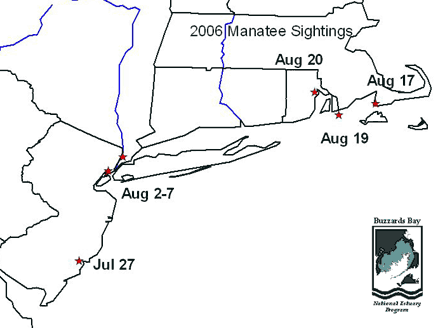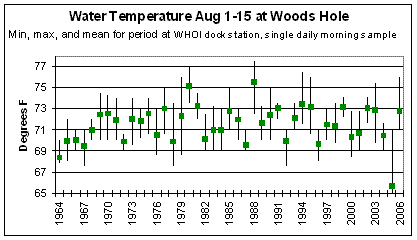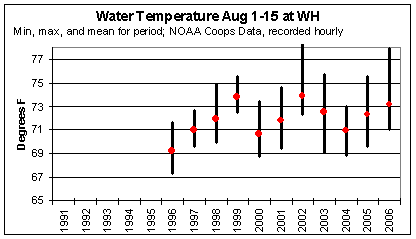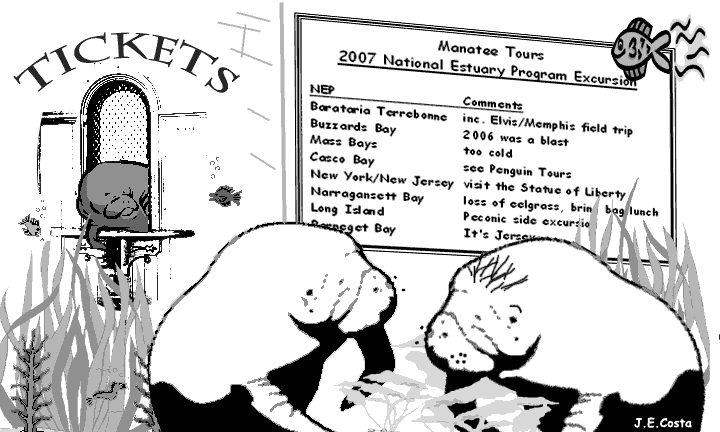by Dr. Joe Costa, Buzzards Bay NEP Director
The Florida manatee, a sub-species of the West Indian manatee, is primarily found along Florida’s Atlantic and Gulf coasts. On the Atlantic side of their range, herds sometime venture into Georgia and the Carolinas. A few individuals have also ventured as far as Massachusetts during warm months. A good summary about the species is found at this Florida Fish and Wildlife Conservation Commission web page. Manatees require access to fresh or brackish water to drink, and sightings are often associated with a manatee drinking from a freshwater pipe discharge along the waterfront. Below is a summary of past occurrences of manatees in Buzzards Bay.
July 2024: Unconfirmed report of a manatee in Buzzards Bay
On July 18, we received a report that the captain of a vessel saw a manatee in Buzzards Bay while traveling out of Onset. We have not received reports of other sightings in Buzzards Bay. There have been other northward sightings of manatees outside their normal range during the summer of 2024. On June 18, a manatee was observed in the Western Branch of the Elizabeth River in Norfolk, Virginia according to according to a WTKR report. On July 9, according to a WNCN story, an entire herd of Manatee was reported in intracoastal waterways between Hampstead and Wrightsville Beach in North Carolina.
2023: Manatee reported in Rhode Island
Several newspaper outlets reported the appearance of a manatee first observed September 11 in Quonochontaug Pond in Rhode Island. It was later observed at other sites including in Point Judith Pond, in Narragansett, and in the Warren River. On October 6, it was found dead in an advanced stage of decomposition near Prudence Island in Narragansett Bay with an unknown cause of death according to this AP story in the US News & World Report. Prior to the Rhode Island manatee appearance, in early August, Manatees were reported in upper Chesapeake Bay.
2016: A Manatee named Washburn
Between mid-August and September 22, 2016 a manatee was repeatedly observed on the south side of Cape Cod, mostly along the shores of Falmouth. It likely passed through Buzzards Bay, although no one had reported seeing it. On September 22, the animal was rescued because of rapidly dropping water temperatures. The animal was brought to the Mystic Aquarium in Connecticut for rehabilitation. Named Washburn, because it was observed and captured off Washburn Island in Falmouth, it was originally thought to be a male. Washburn turned out to be a pregnant female manatee. On October 18, the manatee was flown by a US. Coast Guard plane to Sea World in Florida. Read this September 22, 2016 Falmouth Enterprise newspaper article: roaming manatee found and rescued.
Late summer 2008: A manatee ventures into Cape Cod Bay
As we describe below, in August 2006, a manatee traveled up the east coast, entered Buzzards Bay, spent a day or two here than began its return trip to Florida. This event was the northernmost recorded migration of a manatee. That was until late in September 2008, when a manatee either crossed or traveled up Buzzards Bay to appear in the cold waters of Cape Cod Bay in East Dennis, MA, on the north side of Cape Cod about October 1, 2008. The Manatee could not find its way back around Cape Cod, so on October 12, a rescue was attempted by a wildlife rescue group from Florida. These rescuers moved the stressed manatee from harbor onto a floor of the truck. The manatee died when the rescuers drove the ailing manatee for 27 hours straight to Florida. The rescue attempt appeared ill-conceived. Placing a severely stressed 1000-pound animal never out of water on an uncushioned truck floor for a long trip seemed unwise. Later, Florida wildlife officials concluded that an attempt should have been made to rehabilitate the animal locally until it was healthy before transporting it.
Was this the same manatee as observed in 2006?
Like the 2006 manatee, the 2008 manatee stopped in Rhode Island at Point Judith. Remarkably, this manatee stopped at exactly the same stormwater drainage pipe in the harbor as the 2006 manatee as illustrated by 2006 and 2008 photos below. This seems like a remarkable coincidence, and would seem to suggest that the 2008 manatee was just following the route it learned 2006. However, pipes discharging freshwater attract manatees because they look for freshwater sources to drink. In addition, the 2008 manatee is missing its left front flipper, whereas there were no reports in the 2006 stories about the manatee being so impaired. (Of course, it is possible the manatee had its accident after 2006. No photos seem to be available of the 2006 manatee’s tail.) Without more photos of the earlier manatee, it would be difficult to match the two animals.
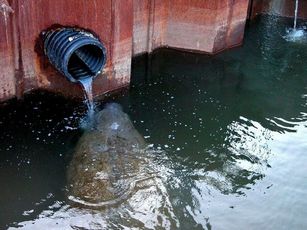
2008 Photo of a Manatee in Rhode Island
by Sgt. Francis Either, RI ENV POL.
Compare to 2006 image below
Unusual Northern Excursion
The appearance of the manatee on the north side of Cape Cod is quite surprising because the waters are so cold there, although this time of year, and with our currently mild early October days, the difference between Buzzards Bay and southern Cape Cod Bay is only around 4 degrees Fahrenheit (based on satellite and NOAA weather buoys; BUZM3= 63.1° Boston =57° 10 October 2008).
Did the manatee travel through the Cape Cod Canal? We thought so, but there was what appeared to be a credible report in the Cape Cod Chronicle (a local weekly paper) on October 2, which described a Monday September 29 interview with an Eastham resident saying that he say a manatee “last week” in Round Cove in Pleasant Bay. We presume this would place the encounter on Friday September 26 or earlier. The interview predates the October 1 appearance of the manatee in Cape Cod Bay. It is also consistent with daily travel distances possible based on the September 18 observations in the Taunton River in Narragansett Bay, and the 2006 daily travel distances. If this account accurate, it suggests the manatee would have rounded Provincetown and appeared in East Dennis 5 days later, a plausible timeline. It is also possible manatee would also have had enough time to have returned to Buzzards Bay and travel up the canal for its first appearance in Cape Cod Bay on 1 October.
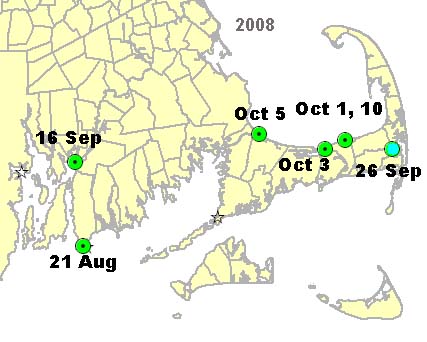
Could the manatee have returned south on its own? If the manatee has the ability to reckon south, Cape Cod would pose a tremendous obstacle to it. It would have to either find the Cape Cod Canal at a time when tidal water flow is south. Otherwise it would have to retrace its route north around Provincetown. If it found the Canal at the wrong time in the tidal cycle, it would seem unlikely that a manatee would try to fight a 6 knot current if the tides were flowing against it. Timing would also be important in a trip around Provincetown to avoid strong northward tidal currents on the outer Cape.
A manatee visits Buzzards Bay (our original 2006 story)
In late summer, or after storms, we often hear reports of oceanic or tropical animals not often found in Buzzards Bay. On August 16, 2006 we received a call that a large ocean sunfish (Mola mola) had drifted into Buttermilk Bay and was mistaken for a shark. We also heard that a pod of dolphins were observed in the Cape Cod Canal that same day. Most remarkable, however, was the Falmouth Enterprise report that a West Indian manatee (sea cow) was sighted by several sources in Quissett Harbor on August 17 (Read the Enterprise article; note Quissett Harbor is called “Gansett Harbor” in the article). Normally the slow moving manatees, with adults weighing more than a 1000 pounds, are found in the US only in Florida year round, but often venture as far north as Virginia (and as far west as Alabama) during the summer.
On August 22, the Falmouth Enterprise reported (read the article) that the manatee seen in Quissett Harbor on August 17 was seen in Rhode Island several days later. On Saturday it was seen near the Rhode Island- Massachusetts border, and on Sunday it was seen in Greenwich Bay late on Sunday August 20. The Rhode Island TV station WJAR 10 showed a video of the manatee in a busy marina drinking water from a drain.
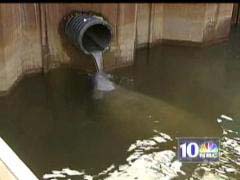
Image from 2006 Manatee in Rhode Island Video
The manatee reported in Falmouth is likely the same manatee reported along the central US coast this summer. Other well documented visits were in the Hudson River and near Manhattan earlier this month, and in Delaware and New Jersey in July. (Read this CNN article and July 27 New Jersey report.) The previous extreme range reported for manatees in the US had been Texas to Rhode Island, so this manatee has set a new documented distance record.
In 1995, a radio tagged manatee, nicknamed Chessie, traveled north, past the Statue of Liberty and Hudson River, all the way to Rhode Island (to point Judith) after which he turned around and returned to Florida. In 1996 and 2001, Chessie was positively identified as returning to Virginia waters (read these Chessie stories: USGS article and Oceanic Research Group, Inc. article). In 1998, an unidentified manatee was observed off Long Island. Cathy Beck, a wildlife biologist at the U.S. Geological Survey in Florida who has been studying manatees, has reviewed photographs of the manatee’s Rhode Island visit and concluded that this is not Chessie, and the manatee may not even be in their manatee data base. (Manatees, incidentally, can live more than 60 years.) Then who is this Leif Ericson among manatees?
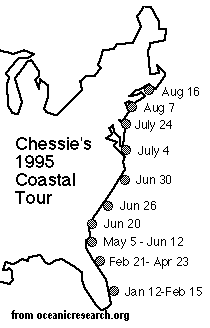
The travel time frame between sightings in Massachusetts and Rhode Island is realistic for a manatee. Below we show a map produced by Oceanic Research Group, Inc. of Chessie’s 1995 trip showing its radio tracked trip north, compared to the various press reports we compiled for the 2006 manatee. As shown, the travel times, distances traversed, and even appearance dates are remarkably consistent, and it is quite plausible that a manatee traveled 60 miles in three days between Quissett Harbor (near Woods Hole, MA) and Warwick, RI. Manatees are not ocean going and instead travel close to the shore. They are herbivores and eat seagrasses and algae. Manatees may require freshwater to drink, and many of the recorded appearances of manatees have been at marinas and other populated areas where fresh water may be flowing from a hose or pipe.
So if you think your eyes are playing tricks on you, and you think you see a manatee, please give us a call. Perhaps next summer, about mid-August someone will stick a hose in the water off their dock, and sit on a chair with a camera in hand waiting for the manatee to reappear, and obtain the first-ever photograph a manatee in Buzzards Bay. One word of caution: manatees are a US endangered species and are often injured and sometimes killed by boat propellers. If you are in a boat, please keep your distance if you ever do see a manatee in Buzzards Bay.
Were warmer waters in Buzzards Bay a factor?
The appearance of a manatee in New England is clearly a serendipitous event, and requires two key ingredients: a willing manatee and warm water. Manatees prefer waters above 70 degrees Fahrenheit, and do not survive prolonged periods with water temperatures below 68 degrees F. There has been speculation in the press that waters were exceptionally warmer in the northeast this summer, but that does not appear to be case. Water temperatures in southern New England are typically highest in the first two weeks of August, which coincides to the time period of previous manatee sightings in southern New England. Because Buzzards Bay and other southern New England areas are relatively shallow, they are strongly influenced by daytime high air temperatures, and nighttime lows. Our area is also affected by meanders of the Gulf Stream, and sometimes eddies of Gulf Stream water (“warm core rings”) may drift into near coastal waters. These warm core rings and Gulf Stream meanders often bring with them a variety of exotic tropical fish that are a delight for local divers.
With our early August heat wave, mean and minimum water temperatures in Woods Hole were warmer than average, but several other recent years had higher average temperature and higher minimum temperatures for the same August period as shown in the graphs below. Clearly coastal water temperature alone does not explain the appearance of manatees in New England.
